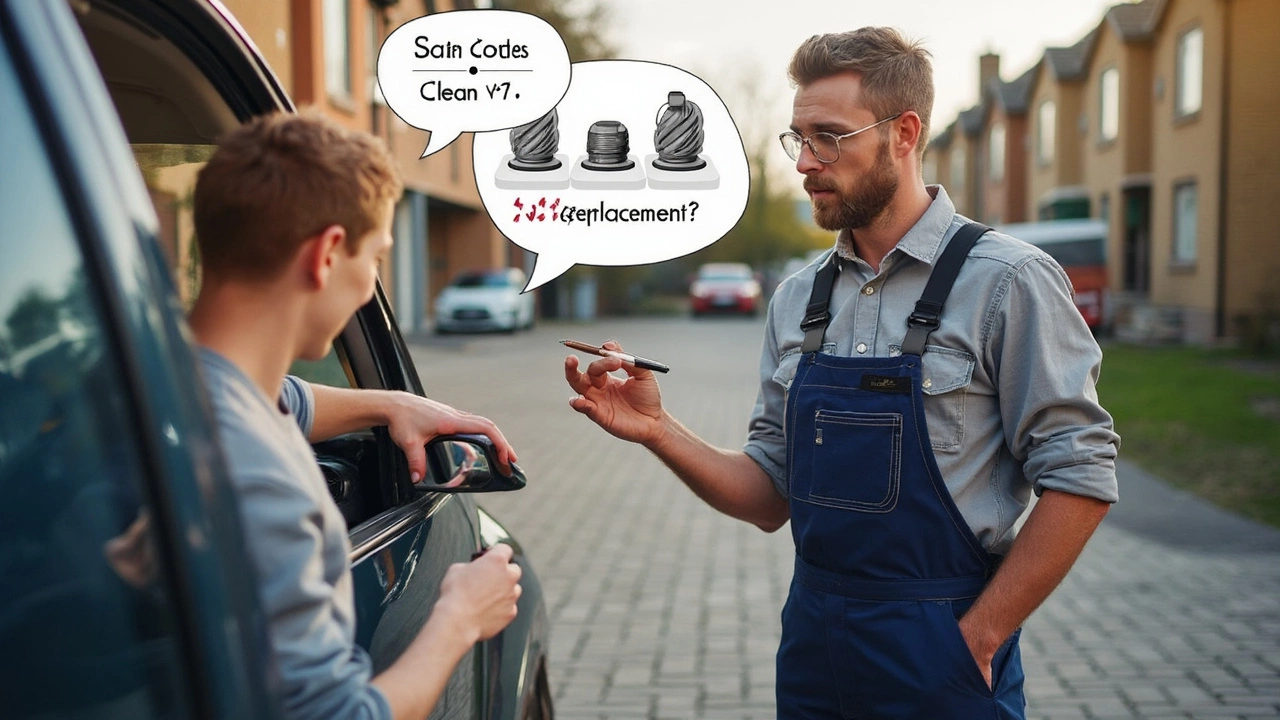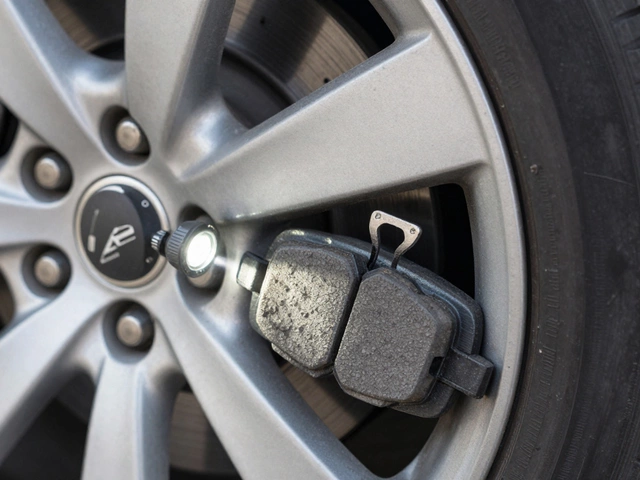Ever notice your engine acting sluggish, your gas mileage dropping, or starting up taking longer than it should? One of the usual suspects is a set of grungy spark plugs. These tiny parts do a massive job, lighting up the fuel in your engine and keeping everything running smooth. So when they go bad, the whole car feels it.
Lots of folks think cleaning spark plugs is a quick fix—cheaper, less hassle, and just as good as buying new ones. Sounds great, right? But here's the thing: not all spark plugs are built for a second life. Cleaning might save you a few bucks now, but it could cost more down the road if your engine keeps misfiring or won’t start at all. On the flip side, replacing plugs every time isn’t always needed either, especially with the new long-lasting designs out there.
- Why Spark Plugs Matter
- Cleaning vs. Replacing: What Really Works?
- How to Spot a Bad Spark Plug
- Best Practices to Make Spark Plugs Last
- Common Misconceptions About Spark Plug Care
Why Spark Plugs Matter
It’s easy to forget about spark plugs since they’re tucked away inside your engine, but they have a big job. These plugs fire electricity to ignite the air-fuel mix in each cylinder, which sets everything in motion. No spark, no combustion—that means your car won’t start, or it’ll run rough and waste gas.
Let’s break down what makes working spark plugs so crucial:
- Engine Performance: Healthy spark plugs help your engine run smooth, deliver power, and keep those stutters and stalls away. You’ll notice the difference if they start going bad—acceleration drops, idling gets rough, and you might even hear odd noises.
- Fuel Efficiency: Firing up that fuel-air combo with the right timing burns gas cleaner. According to the U.S. Department of Energy, misfiring spark plugs can drop your fuel efficiency by up to 30%. That’s like tossing cash out your exhaust.
- Emissions: Bad spark plugs lead to incomplete combustion, which bumps up your emissions. If your car’s due for a smog test, old plugs could mean a fail.
- Starting Reliability: Nothing’s more annoying than a car that won’t start in the morning. Old or dirty plugs make cold starts harder, especially when it’s chilly.
Here’s a quick snapshot showing what can happen when spark plugs start to wear out:
| Symptom | Possible Issue |
|---|---|
| Engine Misfires | Worn electrodes or fouling |
| Hard Starting | Weak or no spark |
| Poor Mileage | Incomplete combustion |
| Rough Idling | Unreliable spark timing |
Bottom line: keep your spark plugs in check if you want your car to stay dependable, efficient, and legal on emissions. Whether you drive a Toyota Corolla or something sportier, these tiny parts pack a punch.
Cleaning vs. Replacing: What Really Works?
Lately, there’s a ton of talk about whether it makes sense to clean your spark plugs or just shell out for replacements. It sounds tempting to grab a wire brush, knock off the carbon buildup, and call it a day. But does cleaning actually get you the same results as a fresh set?
Here’s what actually goes down: When a spark plug gets dirty, it means carbon, oil, or fuel deposits are building up on the tip. This junk messes with the spark needed to ignite the air and fuel in your engine. Cleaning helps remove some of that junk, but it doesn’t restore the wear on the electrode or fix cracks in the ceramic. That means even if a plug looks shiny after a cleaning, it still might not perform as well as new.
Modern spark plugs, especially ones with platinum or iridium tips, are made to last. You can get upwards of 60,000 or even 100,000 miles out of these before they’re toast. But here’s the kicker: cleaning might actually scrape off the precious metal tips, making expensive plugs wear out faster. And if the plug is cracked or fouled with oil, no amount of scrubbing will save it. That’s dead weight you just need to replace.
| Method | Pros | Cons |
|---|---|---|
| Cleaning Spark Plugs | Cheap, quick, some life extension for lightly used plugs | Can’t fix wear or damage, risky for fancy plugs, may mask bigger engine issues |
| Replacing Spark Plugs | Restores full performance, fixes wear/damage, lasts longer | Costs more up front, takes extra time if you do it yourself |
If your car uses old-school copper spark plugs, you might get away with cleaning as a temporary fix. But with most newer cars, cleaning is really just a short-term Band-Aid. If you’re having regular trouble, spend the extra cash on new plugs, especially if your budget allows. It’s one of those things where saving now can mean paying more later—trust me, I’ve stared down a roadside breakdown because I tried to stretch my plugs too far.

How to Spot a Bad Spark Plug
You don’t need to be a mechanic to catch a failing spark plug before it leaves you stranded. Some signs are obvious, others are sneakier, but they all mess with your ride’s performance and wallet. Let’s break down what to watch for.
- Rough Engine Idle: If your car shakes, rattles, or sounds uneven when stopped, you could have a bad spark plug.
- Trouble Starting: Harder-than-usual starts or an engine that won’t catch is a classic sign.
- Poor Fuel Economy: Suddenly getting fewer miles per tank? Misfiring plugs waste gas like it’s going out of style.
- Engine Misfires or Hesitation: Hesitation, jerking, or “coughing” when hitting the gas often points right at your spark plugs.
- Check Engine Light: This one’s obvious, but don’t ignore that dashboard warning—it could be as simple as a failing plug.
Popping the hood? Here’s what a worn or dirty spark plug might look like:
- Black, oily, or wet tips: This means oil, fuel, or coolant is getting places it shouldn’t.
- White or blistered tips: That’s a sign of your engine running too hot—maybe from the wrong fuel mix or overheating.
- Cracks or chips: Any busted ceramic or metal is a hard no-go.
- Heavy carbon deposits: Black soot usually means the fuel mixture is too rich, or you drive a ton of short trips.
For drivers who love details, here’s a simple table showing when to start checking your plugs based on type:
| Plug Type | Usual Life (Miles) |
|---|---|
| Copper | 20,000 - 30,000 |
| Platinum | 60,000 - 100,000 |
| Iridium | 80,000 - 120,000 |
Bottom line: Bad spark plugs don’t hide for long. If your car does anything weird or the plugs look rough, it’s time to give them some attention—either a deep clean (if they’re not too far gone) or a swap for new ones.
Best Practices to Make Spark Plugs Last
Want your spark plugs to stay in top shape for as long as possible? Start with good old-fashioned scheduled maintenance. Most car makers say to swap plugs every 30,000 to 100,000 miles, depending on the type—check your owner’s manual for the real scoop. Missing these intervals is a surefire way to run into trouble.
Keep in mind, the type of plug makes a big difference. Platinum and iridium plugs last way longer than basic copper plugs. They’re more expensive up front, but they can go four times longer before needing a change. Might sound like sales talk, but check out this straight advice from NGK, a big name in the game:
“Iridium spark plugs provide the longest lasting performance and can withstand harsher conditions, making them the go-to choice for drivers seeking less-frequent maintenance.”
Besides picking the right plugs, dirty or old air filters are spark plug killers. If dust and gunk make it inside your engine, your spark plugs foul up fast. Check and change the air filter just like the manual says—usually every 12,000 to 15,000 miles.
- Don’t let oil leaks slide. Oil on plug threads or the ceramic part means something’s wrong (think leaky valve cover gasket). Fix the leak or you’ll be replacing plugs far too soon.
- Fuel quality matters more than most folks think. Cheap gas full of additives or water will gum up your plugs in a hurry. Stick to trusted brands and avoid the bargain-basement stuff.
- Engine running rough? Track it down. Rough idling, hesitation, or a check engine light can mean a deeper issue that causes spark plug damage if left alone.
If you’re up for it, check your plugs yourself every so often. Look for signs of wear, oil, or burn marks. A little white coloring is normal, but heavy, crusty buildup screams for attention.
| Spark Plug Type | Average Lifespan (Miles) |
|---|---|
| Copper | 20,000 – 40,000 |
| Platinum | 50,000 – 80,000 |
| Iridium | 60,000 – 120,000 |
Keeping up with these easy tasks doesn’t just keep your spark plugs happy. It means fewer headaches, less money dumped into surprise repairs, and more time spent actually enjoying the drive instead of fighting with it.

Common Misconceptions About Spark Plug Care
There’s a ton of myths out there about taking care of spark plugs. Some sound believable, but they can actually lead to more headaches—and even costly repairs—down the line.
First up: "You should always clean and reuse a spark plug to save money." Sure, cleaning might seem like an easy win, but modern plugs aren’t always meant for repeated use. Automotive engineers will tell you that older copper plugs could handle a cleaning or two, but most newer iridium and platinum spark plugs are designed to be replaced. Scrubbing them down too hard can ruin their special coatings and cause more misfires.
Another common belief is, "If the car’s not misfiring, the spark plugs must still be good." That’s not true. Worn spark plugs often cause small problems before you ever feel a rough idle or see a check engine light. You might notice getting worse gas mileage or needing more cranks to start the engine. Don’t ignore those signs, thinking everything’s fine just because the ride seems smooth.
People also think all spark plugs last the same amount of time. That’s outdated advice. Here’s a quick comparison:
| Type of Spark Plug | Average Lifespan |
|---|---|
| Copper | Up to 30,000 miles |
| Platinum | Up to 60,000 miles |
| Iridium | Up to 100,000 miles |
So, if your car takes iridium plugs, don’t bother checking them every 20,000 miles unless you’re having issues. On the flip side, sticking copper plugs in and forgetting about them for 80,000 miles isn’t smart—those will break down long before that.
Some people swear by "home brew" cleaning methods, like using a wire brush or sandpaper. That’s risky. It can scratch the plug’s surface or leave behind debris, leading to poor engine performance or even damage inside the cylinder. Always use a proper plug cleaner or, honestly, just swap out for a new set if you’re unsure.
One last myth: "Aftermarket or premium spark plugs will magically improve horsepower and MPG." That’d be nice, but usually, sticking with what the manufacturer recommends is your best call. Putting in fancy racing spark plugs in a regular sedan won’t give you racecar results; if anything, it could mess with the engine computer’s settings.






